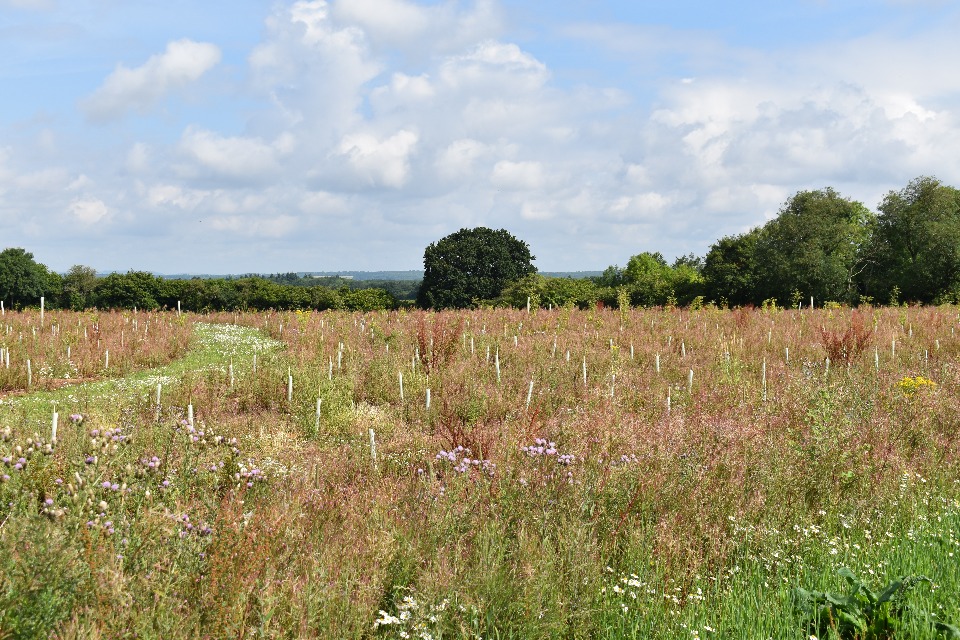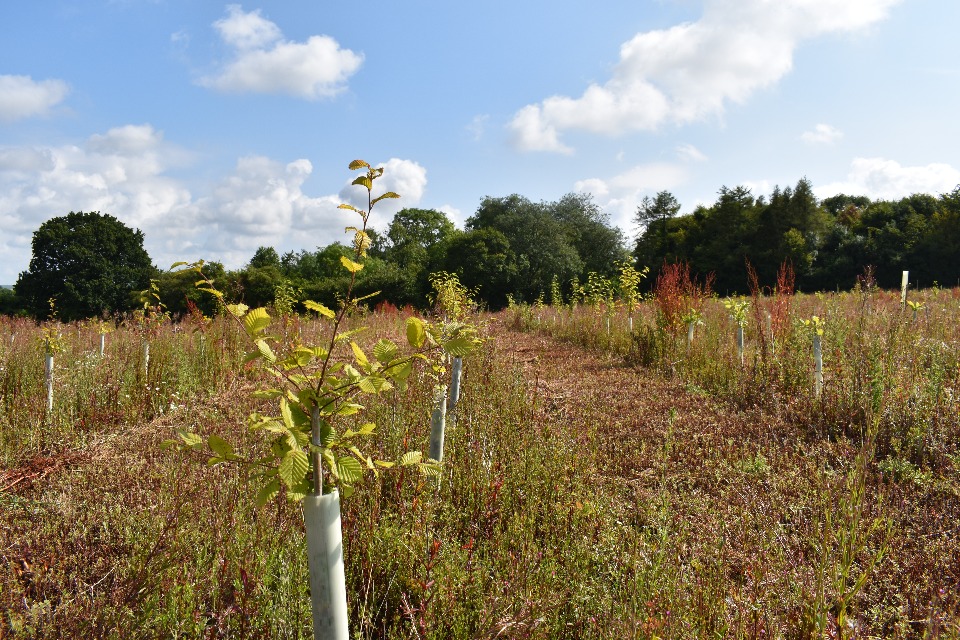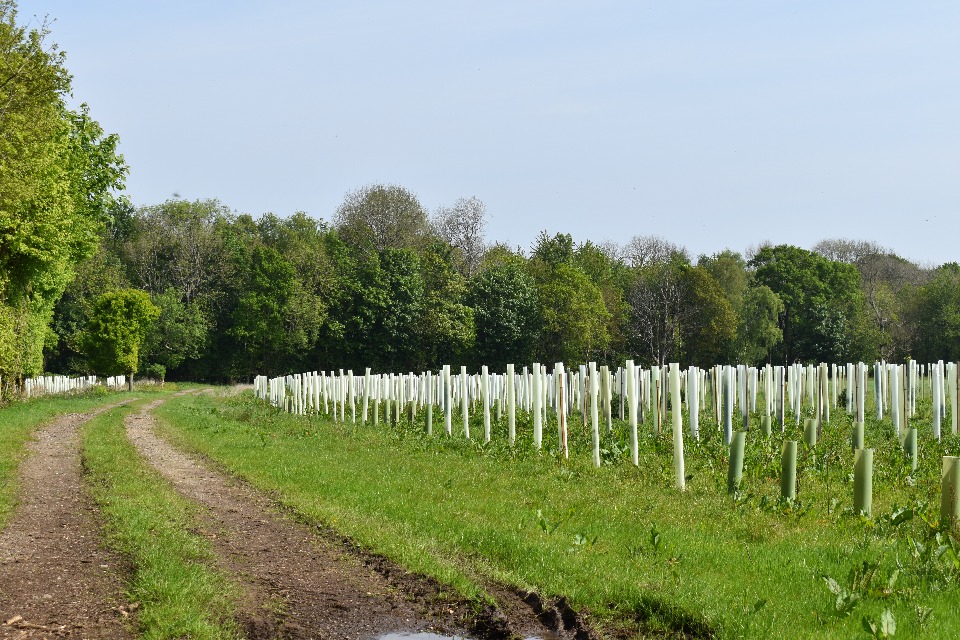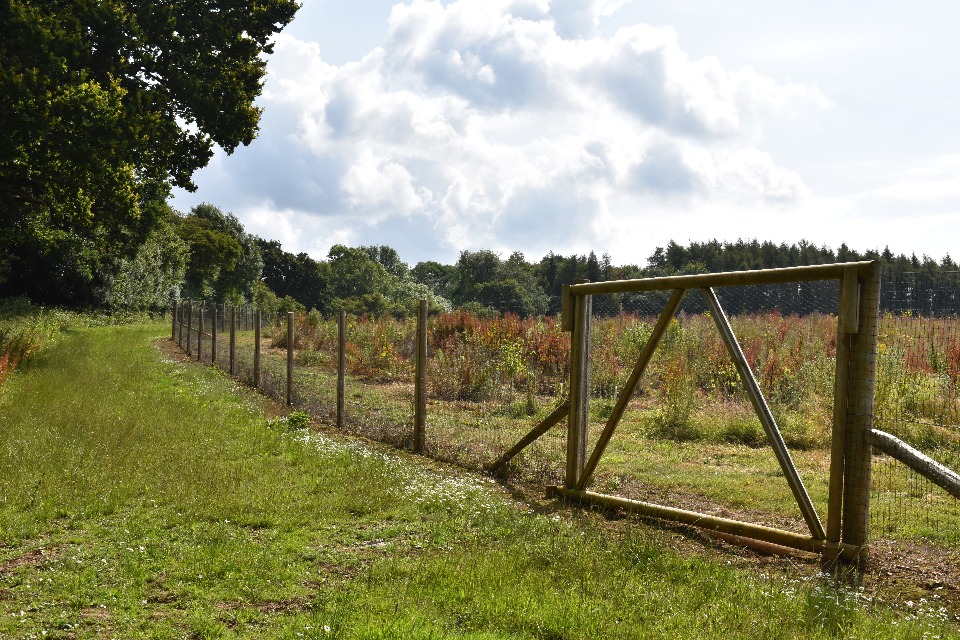Regenerative farming: reducing carbon emissions and bolstering biodiversity at Newhouse Farm
A woodland creation case study on cutting on-farm carbon emissions, increasing biodiversity and diversifying business
Key facts
- site: Newhouse Farm, Hampshire
- size: 800 hectare farm, 70 hectares of existing woodland, 12.2 hectares of new planting
- species: mixed broadleaf and conifer including pedunculate oak, beech, small-leaved lime, hornbeam, wild cherry, Japanese cedar and yew. Scrub species include hawthorn, blackthorn, crab apple and whitebeam
- grants: Woodland Creation Planning Grant (WCPG) and England Woodland Creation Offer (EWCO)
- key objectives: to cut on-farm carbon emissions, increase biodiversity, and diversify the business to include apple sauce production as part of their meat box scheme

A woodland creation site at Newhouse Farm, showing planted trees with guards. Copyright Newhouse Farm.
Newhouse Farm Partnership
Hampshire farmer Andy Bason and his team at Newhouse Farm are planting trees as they develop a regenerative farming system on their 800 hectare (ha) farm.
Their goal is to reduce carbon emissions and enhance biodiversity whilst maintaining profitability across 600ha of combinable crops, including wheat, barley, oats, oilseeds, peas and beans. They also rear rare breed Gloucester Old Spots pigs and a mix of Hampshire Down and Herdwick cross sheep, selling their produce directly to the local community.
Trees and regenerative farming
Newhouse Farm sustainably manages 70ha of woodland, including hazel copse and ancient woodland, to supply wood and woodchip for heating 5 houses and various commercial units. The farm operates a 100 kW and a 30 kW Guntamatic woodchip boiler, as well as a 110 kW woodchip boiler, replacing the need for 7 oil-fired boilers. The farm follows a 10-year woodland management plan to maximise natural resources and ensure their longevity.

A close up of a planted tree in a row of young trees. Copyright Newhouse Farm.
Tree planting has resulted in the creation of over 12ha of new woodland, funded through the Woodland Creation Planning Grant (WCPG) and the England Woodland Creation Offer (EWCO). Newhouse Farm received over £66,000 to cover capital items and more than £72,000 in annual maintenance payments spread over 15 years to ensure the successful establishment of the woodlands.
A further one-off payment of approximately £20,000 was granted as additional contribution payments, recognising the new plantings’ contributions to both biodiversity and water quality.
Making use of marginal land
Over 11ha of low grade, heavy clay, and ex-arable land was planted with a mix of predominantly native broadleaf plus some native and near native conifers. This serves as a haven for local wildlife and offers a legacy for future generations to enjoy.
An additional 0.8ha was planted to link 2 ancient/semi-natural blocks of woodland which will go on to create a corridor between arable fields, connecting habitats and supporting nature recovery, whilst also acting as a shelterbelt offering protection to both soil and crops from severe weather.

Rows of newly planted trees with guards. Copyright Newhouse Farm.
Newhouse Farm is developing a trial of agroforestry strips, initially designed as a series of beetle banks, to test growing timber and fruit crops alongside their arable rotation. In response to a significant fallow deer population in the area, the team is focusing on protective measures and coordinated deer management.
Venison from these efforts already features in their meat box schemes, alongside on-site pork and lamb, showcasing a range of sustainable, locally sourced products. Looking ahead, the apples from their agroforestry system are intended for apple sauce to complement the meat boxes and to supply a local cider producer.
Protecting saplings from mammal damage
Advice from a local independent forestry agent was sought to support the woodland creation plan, ensuring concerns around deer, voles and hares were mitigated. In the local landscape, roe and fallow deer are the main species present. Due to the transient presence of fallow herds, deer fencing was erected to protect the newly planted trees during their establishment phase. This method was more cost-effective, environmentally friendly, and landscape-sensitive in comparison to using 1.8m tree shelters.
The 1.8m deer fencing comprised of chestnut stakes, tenex plastic netting, and strands of straining wire, with additional rabbit netting to prevent access by hares and rabbits. 60cm spirals and canes were used around the trees for vole protection. Ongoing deer and squirrel control will be implemented, including 2 new deer high seats. After the 10-year establishment phase, the tree protection fencing may be removed if the trees are successfully established.
The design of the new woodland also considered the practical requirements for the trees’ aftercare during the establishment and maintenance phase. During establishment, the hand screening technique was applied, limiting soil disturbance to keep carbon in the soil. Hand screening is a technique used to prepare the ground for tree planting. It involves manually clearing away vegetation and organic matter from the planting spot to expose the soil beneath. This process helps to create a suitable planting environment by reducing competition from weeds and other vegetation, which can otherwise impede the growth of young trees.

Fencing to protect the new planting. Copyright Newhouse Farm.
Encouraging biodiversity
As the trees are establishing, the team at Newhouse Farm are already seeing ducks and dragonflies making use of the new pond within the planted area, as well as pollinators on the naturally regenerated phacelia, which has grown under the young trees.
The diversity of tree species will not only benefit a range of local wildlife, but also promote resilience against a changing climate and pests and diseases, which are an increasing threat to our existing woodlands and landscape.
Reducing carbon emissions
Before work on the site began, the Newhouse Farm team registered for the Woodland Carbon Code and applied for the Woodland Carbon Guarantee. The Woodland Carbon Code will allow the farm to benefit from additional long term income and provides an opportunity to offset its own carbon emissions. The Woodland Carbon Guarantee would then allow landowners to sell their captured carbon as verified carbon credits.
The project (covering a net planting area of 9.84 ha) is predicted to sequester 4,352 tonnes of CO2e over 100 years, with a predicted availability of 3,482 Woodland Carbon Units (WCUs).
By making use of both the Woodland Carbon Code and Woodland Carbon Guarantee, Newhouse Farm has reduced the risk associated with the permanent land use change to woodland by providing a clear income projection.
This projection is crucial for benchmarking against other income options and can also drive improvements on less productive areas of land where alternative income opportunities are limited.
Top tips
- seek advice from a range of stakeholders - there is a wealth of knowledge in the sector to help support and advise on the management of trees, to make them a viable and valuable part of a farm business
- consider your long-term plan and the needs of the trees to maximise the benefits on your farm - tree planting needs to be underpinned by appropriate management, and some considerations are ongoing, such as the management of deer, hare and other mammals
- ask your neighbours or local farm cluster members - they may have gone through the planting process and be willing to share their experiences
- learn from doing and be willing to share your experiences - it may help others
Andy Bason, Farm Manager, Newhouse Farm said:
One piece of advice for woodland management or creation is seek advice early on!
Find out how the Forestry Commission can help you create woodland, visit our Tree planting and woodland creation overview.